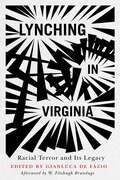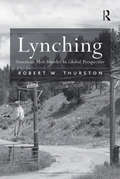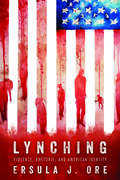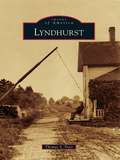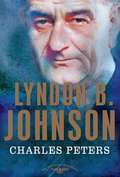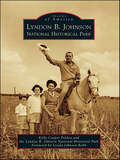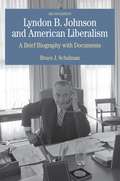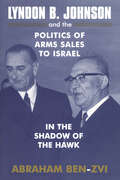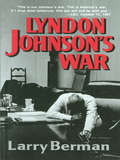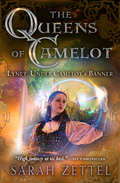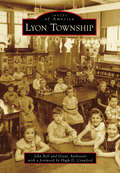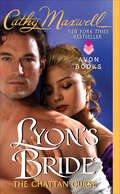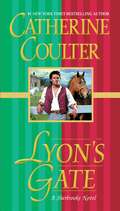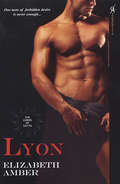- Table View
- List View
Lynching in Virginia: Racial Terror and Its Legacy (The American South Series)
by W. Fitzhugh BrundageUncovering the history and examining the legacy of lynching in the state of Virginia Although not as associated with lynching as other southern states, Virginia has a tragically extensive history with these horrific crimes. This important volume examines the more than one hundred people who were lynched in Virginia between 1866 and 1932. Its diverse set of contributors—including scholars, journalists, activists, and students—recover this wider history of lynching in Virginia, interrogate its legacy, and spotlight contemporary efforts to commemorate the victims of racial terror across the commonwealth. Together, their essays represent a small part of the growing effort to come to terms with the role Virginia played in perpetuating America&’s national shame.
Lynching in the New South: Georgia and Virginia, 1880-1930 (Blacks in the New World)
by W. Fitzhugh BrundageLynching was a national crime. But it obsessed the South. W. Fitzhugh Brundage's multidisciplinary approach to the complex nature of lynching delves into the such extrajudicial murders in two states: Virginia, the southern state with the fewest lynchings; and Georgia, where 460 lynchings made the state a measure of race relations in the Deep South. Brundage's analysis addresses three central questions: How can we explain variations in lynching over regions and time periods? To what extent was lynching a social ritual that affirmed traditional white values and white supremacy? And, what were the causes of the decline of lynching at the end of the 1920s? A groundbreaking study, Lynching in the New South is a classic portrait of the tradition of violence that poisoned American life.
Lynching: American Mob Murder in Global Perspective
by Robert W. ThurstonAddressing one of the most controversial and emotive issues of American history, this book presents a thorough reexamination of the background, dynamics, and decline of American lynching. It argues that collective homicide in the US can only be partly understood through a discussion of the unsettled southern political situation after 1865, but must also be seen in the context of a global conversation about changing cultural meanings of 'race'. A deeper comprehension of the course of mob murder and the dynamics that drove it emerges through comparing the situation in the US with violence that was and still is happening around the world. Drawing on a variety of approaches - historical, anthropological and literary - the study shows how concepts of imperialism, gender, sexuality, and civilization profoundly affected the course of mob murder in the US. Lynching provides thought-provoking analyses of cases where race was - and was not - a factor. The book is constructed as a series of case studies grouped into three thematic sections. Part I, Understanding Lynching, starts with accounts of mob murder around the world. Part II, Lynching and Cultural Change, examines shifting concepts of race, gender, and sexuality by drawing first on the romantic travel and adventure fiction of the era 1880-1920, from authors such as H. Rider Haggard and Edgar Rice Burroughs. Changing images of black and white bodies form another major focus of this section. Part III, Blood, Debate, and Redemption in Georgia, follows the story of American collective murder and growing opposition to it in Georgia, a key site of lynching, in the early twentieth century. By situating American mob murder in a wide international context, and viewing the phenomenon as more than simply a tool of racial control, this book presents a reappraisal of one of the most unpleasant, yet important periods of America's history, one that remains crucial for understanding race relations and collective violence around the world.
Lynching: Violence, Rhetoric, and American Identity (Race, Rhetoric, and Media Series)
by Ersula J. OreWinner of the 2020 Rhetoric Society of America Book AwardWhile victims of antebellum lynchings were typically white men, postbellum lynchings became more frequent and more intense, with the victims more often black. After Reconstruction, lynchings exhibited and embodied links between violent collective action, American civic identity, and the making of the nation.Ersula J. Ore investigates lynching as a racialized practice of civic engagement, in effect an argument against black inclusion within the changing nation. Ore scrutinizes the civic roots of lynching, the relationship between lynching and white constitutionalism, and contemporary manifestations of lynching discourse and logic today. From the 1880s onward, lynchings, she finds, manifested a violent form of symbolic action that called a national public into existence, denoted citizenship, and upheld political community.Grounded in Ida B. Wells’s summation of lynching as a social contract among whites to maintain a racial order, at its core, Ore’s book speaks to racialized violence as a mode of civic engagement. Since violence enacts an argument about citizenship, Ore construes lynching and its expressions as part and parcel of America’s rhetorical tradition and political legacy.Drawing upon newspapers, official records, and memoirs, as well as critical race theory, Ore outlines the connections between what was said and written, the material practices of lynching in the past, and the forms these rhetorics and practices assume now. In doing so, she demonstrates how lynching functioned as a strategy interwoven with the formation of America’s national identity and with the nation’s need to continually restrict and redefine that identity. In addition, Ore ties black resistance to lynching, the acclaimed exhibit Without Sanctuary, recent police brutality, effigies of Barack Obama, and the killing of Trayvon Martin.
Lyndhurst
by Thomas S. TreerMoses Cleaveland was sent to survey the lands of the Western Reserve of Connecticut into townships in 1796. Due to a strike, the surveyors were given plots within the new Euclid Township as part of their compensation. They sold these plots to arriving settlers from the east. Aristarkus and Sarah Brainard, the area's first family, arrived in 1831. In 1877, the Mayfield Plank Road was constructed allowing a steady stream of people and goods to easily travel from eastern farms to markets found at Doan's Corners in Cleveland, Ohio. As this part of Euclid Township grew, the area became Euclidville Village, later changed to Lyndhurst Village in 1920. The post-World War II building boom brought many young families to Lyndhurst and transformed the sleepy village into a charming 21st-century suburb.
Lyndon B. Johnson (The American Presidents Series)
by Arthur M. Schlesinger Charles PetersPeters, a keen observer of Washington politics for more than five decades, shares his insider knowledge and experiences to tell the story of Johnson's presidency as the tale of an immensely talented politician driven by ambition and desire.
Lyndon B. Johnson National Historical Park
by Kelly Carper PoldenPres. Lyndon B. Johnson took pride in his heritage and in the Texas Hill Country roots of his pioneer ancestors. He delighted in showing guests the ancestral settlement, and his birthplace, boyhood home, and the family treasure: the LBJ Ranch and the home that became known as the Texas White House. LBJ generously gifted these cherished assets to the people of the United States. Lyndon B. Johnson National Historical Park holds more assets significant to an American president than any other U.S. presidential site. Visitors may stroll through the Johnson Settlement, stepping back in time to the 1860s, when President Johnson�s ancestors helped settle Johnson City, which was named after James Polk Johnson, nephew to LBJ�s grandfather. The Boyhood Home and Visitor Center are located close to the Johnson Settlement, and visitors can tour the reconstructed Birthplace and enjoy a scenic drive through the LBJ Ranch before touring the Texas White House. This book illustrates the significance of LBJ�s heritage and the circle of life represented by what is both a birthplace and a final resting place.
Lyndon B. Johnson and American Liberalism: A Brief Biography With Documents (Bedford Series in History and Culture )
by Bruce J. SchulmanWhether admired or reviled, Lyndon B. Johnson and his tumultuous administration embodied the principles and contradictions of his era. Taking advantage of newly released evidence, this second edition incorporates a selection of fresh documents, including transcripts of Johnson's phone conversations and conservative reactions to his leadership, to examine the issues and controversies that grew out of Johnson's presidency and have renewed importance today. The voices of Johnson, his aides, his opponents, and his interpreters address the topics of affirmative action, the United States' role in world affairs, civil rights, Vietnam, the Great Society, and the fate of liberal reform. Additional photographs of Johnson in action complement Bruce J. Schulman's rich biographical narrative, and a chronology, an updated bibliographical essay, and new questions for consideration provide pedagogical support.
Lyndon B. Johnson and the Politics of Arms Sales to Israel: In the Shadow of the Hawk (Israeli History, Politics And Society Ser.)
by Abraham Ben-ZviLyndon B. Johnson and the Politics of Arms Sales to Israel seeks to reconstruct and elucidate the processes behind the decisions made by the Johnson Administration during the years 1965-68 to sell Israel M-48 tanks, A-4 Skyhawk planes and F-4 Phantom planes. This examination is based on a distinction between three factions which competed for influe
Lyndon B. Johnson and the Transformation of American Politics (Library of American Biography Series)
by John BullionThis newest edition to the Library of American Biography Series by John L. Bullion introduces students to the dynamic and turbulent life and legacy of President Lyndon B. Johnson. <P><P>Johnson navigated the country through some of the most challenging issues of the 20th century. This volume offers a close look at not only how Johnson handled the issues of civil rights, segregation, Vietnam, and an unruly economy, but also demonstrates how these same issues and events wore away Johnson’s once robust idealism. <P><P>The titles in the Library of American Biography Series make ideal supplements for American History Survey courses or other courses in American history where figures in history are explored. Paperback, brief, and inexpensive, each interpretative biography in this series focuses on a figure whose actions and ideas significantly influenced the course of American history and national life. At the same time, each biography relates the life of its subject to the broader themes and developments of the times.
Lyndon Johnson's War: The Road to Stalemate in Vietnam
by Larry Berman"Stunning....The portrait of the embattled and unyielding president that emerges is vivid and memorable."--Publishers Weekly By 1968, the United States had committed over 525,000 men to Vietnam and bombed virtually all military targets recommended by the joint Chiefs of Staff. Yet, the United States was no closer to securing its objectives than it had been prior to the Americanization of the war. The long-promised light at the end of the tunnel was a mirage. This absorbing account reveals the bankruptcy of the bombing campaign against North Vietnam, the failures of political reform in South Vietnam and the bitter bureaucratic conflicts between the US government and its military commanders.
Lynet: Under Camelot's Banner (The Queens of Camelot #3)
by Sarah ZettelA maiden fights to bring peace to Arthurian England in this romantic fantasy from an award-winning author. Love finds a way in this epic series featuring swords, sorcery, and the women of Camelot. The daughter of the steward of Cambryn, Lynet has seen the damage that following one’s heart can do. Now the threat of war looms over her land. Desperately searching for a way to restore peace to her home and honor to her family, Lynet and her sister decide that Lynet will seek the help of the last heir to the ancient royal house of Cambryn: the High Queen Guinevere. In Camelot, Gareth, squire of Sir Lancelot, is filled with pride and swagger. But when a potential war calls Queen Guinevere to Cambryn, Gareth finds himself in the company of a young woman who has no patience for his shows of bravado, and for the first time in his life Gareth finds himself with something real to prove. The love growing between Gareth and Lynet is undeniable, but so is the danger into which they are drawn. Only if they come to terms with their pasts and learn to trust again will they be able to overcome the festering darkness threatening to consume them both. Praise for the Queens of Camelot series “High fantasy at its best.” —SFF on Lynet: Under Camelot’s Banner “This novel delivers passion, danger, and excitement laced with fantasy.” —RT Book Reviews on Risa: In Camelot’s Shadow “A spellbinding journey.” —BookLoons Reviews on Elen: For Camelot’s Honor
Lynton Keith Caldwell: An Environmental Visionary and the National Environmental Policy Act
by Wendy Read Wertz“A solid overview of both Caldwell’s contributions and the development of the environmental movement in the US . . . . Recommended.” —ChoiceThis is the story of a visionary leader, Lynton Keith Caldwell, who in the early 1960s introduced the study of the environment and environmental policy at a time when such areas of expertise did not exist. Caldwell was a principal architect of the National Environmental Policy Act of 1969 and is recognized as the “inventor” of the Act’s important environmental impact statement provisions, now emulated around the world. For the next three decades, Caldwell played a leading role in establishing ethics-based environmental policy and administration as major areas of inquiry in the United States and around the world. Through his tireless global travels, writing, and lectures, and his work with the US Senate, the IUCN, UN, and UNESCO, Caldwell became recognized for his contributions to environmental ethics and the development of strong environmental planning and policy. This engrossing biography is based on interviews the author conducted with Caldwell and on unrestricted access to his memorabilia, photos, and records.“Deeply insightful . . . The field of environmental policy is richer for this addition. —H-Net Reviews
Lynx Destiny
by Doranna DurginA lone shifter and a stranger must embrace their deepest fears to defeat a deadly enemy. Forced to return to her family cabin deep in the Sacramento Mountains, Regan Adler is determined to keep her visit brief. Voices that drove her mother crazy are now threatening to do the same to her and she can't ignore them. Then she meets Kai. . . . Kai Faulkes is a lone shape-shifter who takes the form of a lynx. He's aware of the danger approaching but when Regan's soft and sultry voice reaches him, he is thrown into a whole new world of passion that can never be claimed until their common enemy is destroyed! A lynx shifter romance. Previously published.
Lyon Township
by John Bell Hugh D. Crawford Diane AndreassiLyon Township and the unincorporated hamlet of New Hudson are nestled in the southwest corner of Oakland County. They have a rich history of agricultural production. Early 20th-century records show that farmers and families socialized closely with their neighbors in the nearby village of South Lyon when the hard work of the day was done. New Hudson supported two general stores, a tavern, a post office, schools, and churches. However, the start of the I-96 expressway in the 1950s took commuters off the streets and away from local businesses, causing some to close. By the 21st century, the tides turned again, when the proximity to the expressway brought attention to the community and heralded in a new construction boom, earning Lyon Township the distinction in 2012 as one of Michigan's fastest-growing communities.
Lyon's Bride and The Scottish Witch with Bonus Material
by Cathy MaxwellTwo great full-length novels in The Chattan Curse series together in one set from NY Times bestselling author Cathy Maxwell. Includes never before seen "behind the book" info, photos from the author, and a sneak peek to her next series The Brides of Wishmore. Fans of Karen Hawkins, Sabrina Jeffries, and Eloisa James will enjoy these utterly romantic and unforgettable books set in Regency England and Scotland. Lyon's Bride They call him Lord Lyon…proud, determined and cursed. He is in need of a bride, but if he falls in love it's is said he will die. So he seeks a woman to marry without love, hoping to break the curse of the Chattans forever. Enter beautiful Thea Martin—a duke's headstrong, errant daughter and society's most brilliant matchmaker. Years ago, she and Lyon were inseparable, until he disappeared without a word. Now she is charged with finding him his bride—a woman he must not love, for a man Thea could love all too well. The Scottish Witch Portia Maclean believes she is beyond love and marriage. Then, one moonlit night, she finds herself swept off her feet by a powerful stranger. But what will he do once he discovers she's betrayed him? Harry Chattan is fighting for his family…he's come to Scotland on the hunt for a witch to break the Chattan curse. Instead, he finds himself bewitched by Portia. Harry has vowed to fight the demons torturing him, but will that battle destroy her as well?
Lyon's Bride: The Chattan Curse (Chattan Curse Ser. #1)
by Cathy MaxwellA London matchmaker is charged with finding the man she loves a wife in this “delightful” Regency romance from a New York Times bestselling author (Publishers Weekly).“When a Chattan male falls in love, strike his heart with fire from above . . .”They call him Lord Lyon, proud, determined —and cursed. He is in need of a bride, but if he falls in love, he dies. His fervent hope is that by marrying —and having a son—without love, perhaps he can break the curse’s chains forever.Enter beautiful Thea Martin—a duke’s headstrong, errant daughter and society’s most brilliant matchmaker. Years ago, she and Lyon were inseparable, until he disappeared from her life without a word. Now she is charged with finding Lyon’s bride—a woman he cannot love for a man Thea could love too well.
Lyon's Gate: Bride Series (Bride Series #9)
by Catherine CoulterA Sherbrooke novel from the #1 New York Times bestselling author. The year is 1835. Five years after Jason Sherbrooke leaves England for Baltimore and the Wyndhams, one of the premiere racing families in the area, he wakes up early one morning and knows it’s time for him to go home. Jason wants to breed and race horses, primarily his own Thoroughbred, Dodger, who’s faster than a Baltimore pickpocket. When his twin, James, takes him to Lyon’s gate, a once-renowned racing stud farm near his family’s home, Jason knows to his soul that this property is what he wants more than anything. Unfortunately, Hallie Carrick wants Lyon’s Gate just as badly as Jason, and she’s fully prepared to fight him down and dirty to get it. Now life and fate take a hand, and the two of them end up with something neither expected.
Lyon: The Lords Of Satyr (The Lords of Satyr #3)
by Elizabeth AmberThe last in a fabled line of otherworldly aristocracy, the Lords of Satyr are born to wealth, power, and a talent for sensual delight that mere mortals only dream of. Commanded to marry, these passionate men will travel to Rome, Venice, and Paris—and along the way will explore desires both shamelessly wicked and blissfully divine. . .He Is On The Prowl. . . The youngest of the Satyr brothers, Lyon enjoys working in the family's Tuscan vineyards, caring for his menagerie of animals and bedding beautiful women. But he knows he must fulfill his destiny of taking the last daughter of King Feydon as his bride. And so he travels to Paris to wed the infamous Juliet Rabelais. . .For His Most Luscious Prize. . . A celebrated courtesan noted for both her culinary—and carnal—talents, Juliet is a voluptuous beauty with a body meant to tease. And with a full moon only days away, Lyon is quickly aroused. But after a night of intimacy, Lyon wonders if Juliet is truly a mistress of sensual pleasure or whether his sexual mastery will be her undoing. . .Lyon: "Unputdownable." —Paranormal Romance Reviews, Top Pick "Oh, wow. . .an extraordinary read." —CoffeeTime Romance, 5 cups ". . .highly recommended!" —Kwips & Kritiques, 5 stars ". . .a story that will stay with this reviewer for a long time to come." —Wild On Books, Jennifer Ray, 5 starsPraise for Elizabeth Amber and Nicholas. . . "A steamy, hot tale that scorches the pages. Amber's imagination skyrockets!" —Coffee Time Romance "Kept me spellbound." —Joyfully Reviewed
Lyons
by Mark AthitakisDespite its modest size, the village of Lyons has played a key role in the growth of nearby Chicago. In 1673, French explorers Fr. Jacques Marquette and Louis Joliet learned of a Native American portage route connecting the Mississippi River and Lake Michigan, and that path helped make Lyons an important stop for fur traders and other businessmen throughout the 18th and early 19th centuries. In 1834, the town boasted just "a saw mill, three houses, and a tavern," but by the 1830s and 1840s, with the construction of the Illinois and Michigan Canal, Lyons became a boomtown that attracted waves of immigrants from Poland and Germany. Its numerous taverns and outdoor picnics--known as "skillies"--attracted visitors from throughout thearea, who also came to sites like the Cream City Amusement Park and the Hofmann Tower, now a national historic landmark. Lyons, featuring many archival photographs never previously published, explores the town's rich history from its early exploration to the present day.
Lyric Address in Dutch Literature, 1250-1800
by Cornelis van der Haven Jürgen PietersLyric Address in Dutch Literature, 1250-1800 provides accessible and comprehensive readings of ten Dutch lyrical poems, discussing each poem's historical context, revealing its political or ideological framing, religious elements, or the self-representational interests of the poet. The book focuses on how the use of the speaker's I creates distance or proximity to the social context of the time. Close, detailed analysis of rhetorical techniques, such as the use of the apostrophe, illuminates the ways in which poetry reveals tensions in society.
Lyric Apocalypse: Milton, Marvell, and the Nature of Events (Verbal Arts: Studies in Poetics)
by Ryan NetzleyWhat’s new about the apocalypse? Revelation does not allow us to look back after the end and enumerate pivotal turning points. It happens in an immediate encounter with the transformatively new.John Milton’s and Andrew Marvell’s lyrics attempt to render the experience of such an apocalyptic change in the present. In this respect they take seriously the Reformation’s insistence that eschatology is a historical phenomenon. Yet these poets are also reacting to the Regicide, and, as a result, their works explore very modern questions about the nature of events, what it means for a significant historical occasion to happen.Lyric Apocalypse argues that Milton’s and Marvell’s lyrics challenge any retrospective understanding of events, including one built on a theory of revolution. Instead, these poems show that there is no “after” to the apocalypse, that if we are going to talk about change, we should do so in the present, when there is still time to do something about it. For both of these poets, lyric becomes a way to imagine an apocalyptic event that would be both hopeful and new.
Lyric Generations: Poetry and the Novel in the Long Eighteenth Century
by G. Gabrielle StarrEighteenth-century British literary history was long characterized by two central and seemingly discrete movements—the emergence of the novel and the development of Romantic lyric poetry. In fact, recent scholarship reveals that these genres are inextricably bound: constructions of interiority developed in novels changed ideas about what literature could mean and do, encouraging the new focus on private experience and self-perception developed in lyric poetry.In Lyric Generations, Gabrielle Starr rejects the genealogy of lyric poetry in which Romantic poets are thought to have built solely and directly upon the works of Chaucer, Spenser, Shakespeare, and Milton. She argues instead that novelists such as Richardson, Haywood, Behn, and others, while drawing upon earlier lyric conventions, ushered in a new language of self-expression and community which profoundly affected the aesthetic goals of lyric poets. Examining the works of Cowper, Smith, Wordsworth, Coleridge, and Keats in light of their competitive dialogue with the novel, Starr advances a literary history that considers formal characteristics as products of historical change. In a world increasingly defined by prose, poets adapted the new forms, characters, and moral themes of the novel in order to reinvigorate poetic practice.
Lyric Poetry and Modern Politics
by Clare CavanaghLyric Poetry and Modern Politics explores the intersection of poetry, national life, and national identity in Poland and Russia, from 1917 to the present. As a corrective to recent trends in criticism, acclaimed translator and critic Clare Cavanagh demonstrates how the practice of the personal lyric in totalitarian states such as Russia and Poland did not represent an escapist tendency; rather it reverberated as a bold political statement and at times a dangerous act. Cavanagh also provides a comparative study of modern poetry from the perspective of the eastern and western sides of the Iron Curtain. Among the poets discussed are Blok, Mayakovsky, Akhmatova, Yeats, Whitman, Frost, Szymborska, Zagajewski, and Milosz; close readings of individual poems are included, some translated for the first time. Cavanagh examines these poets and their work as a challenge to Western postmodernist theories, thus offering new perspectives on twentieth-century lyric poetry.
Lyric Poetry and Social Identity in Archaic Greece
by Jessica RomneyLyric Poetry and Social Identity in Archaic Greece examines how Greek men presented themselves and their social groups to one another. The author examines identity rhetoric in sympotic lyric: how Greek poets constructed images of self for their groups, focusing in turn on the construction of identity in martial-themed poetry, the protection of group identities in the face of political exile, and the negotiation between individual and group as seen in political lyric. By conducting a close reading of six poems and then a broad survey of martial lyric, exile poetry, political lyric, and sympotic lyric as a whole, Jessica Romney demonstrates that sympotic lyric focuses on the same basic behaviors and values to construct social identities regardless of the content or subgenre of the poems in question. The volume also argues that the performance of identity depends on the context as well as the material of performance. Furthermore, the book demonstrates that sympotic lyric overwhelmingly prefers to use identity rhetoric that insists on the inherent sameness of group members. All non-English text and quotes are translated, with the original languages given alongside the translation or in the endnotes.
